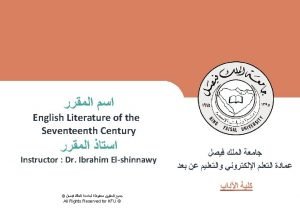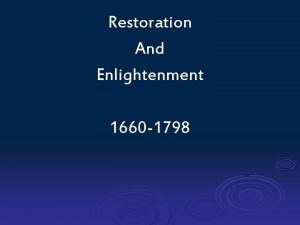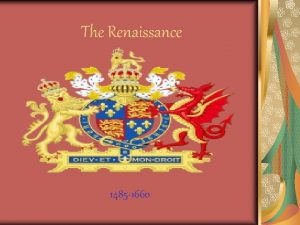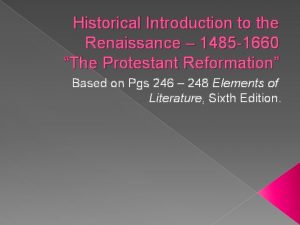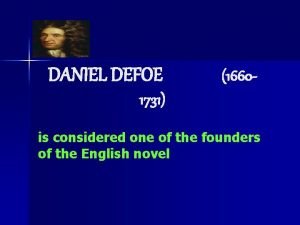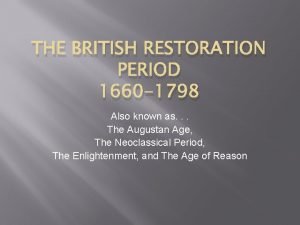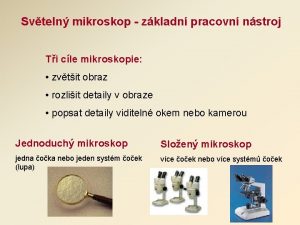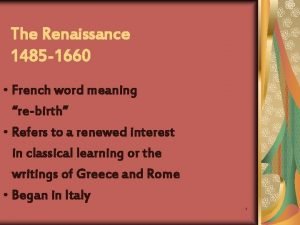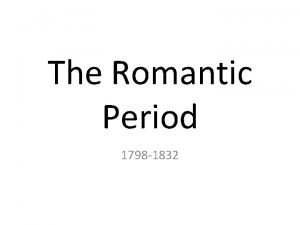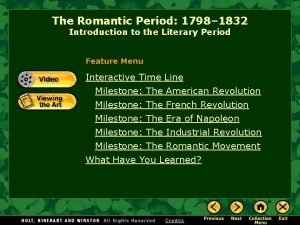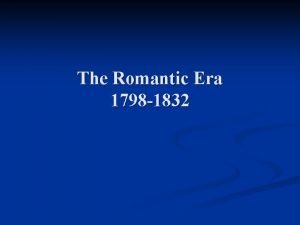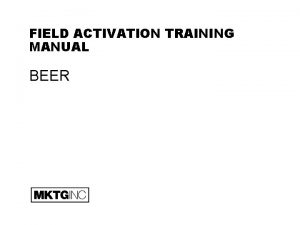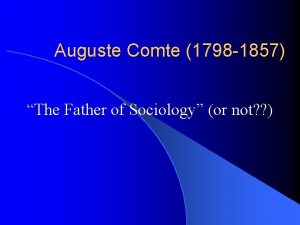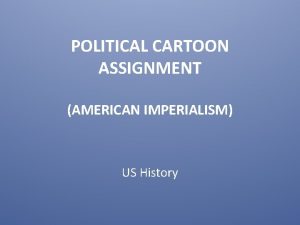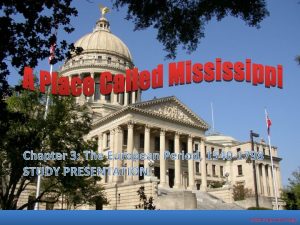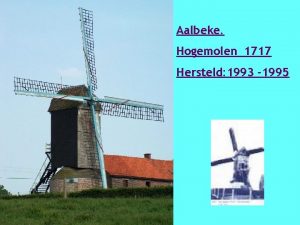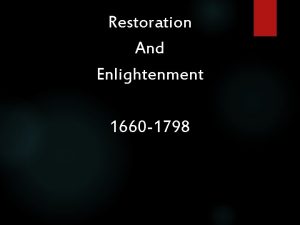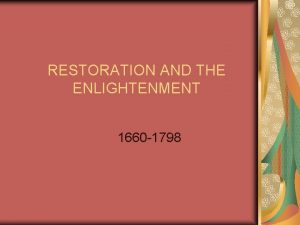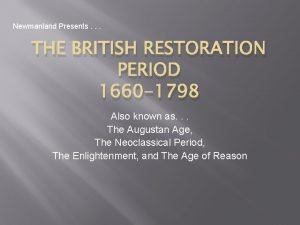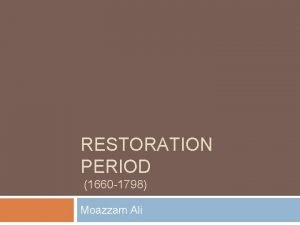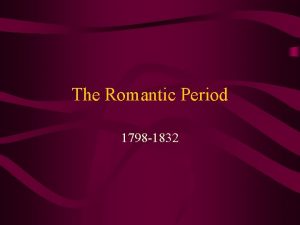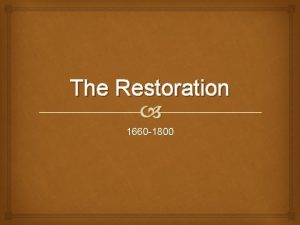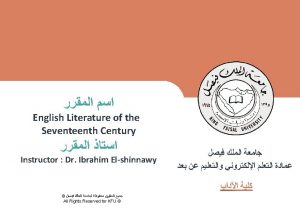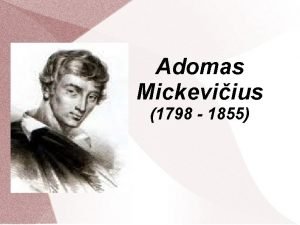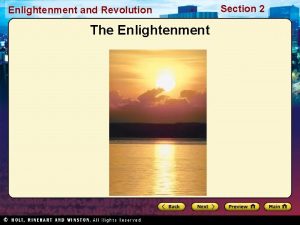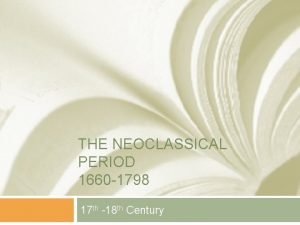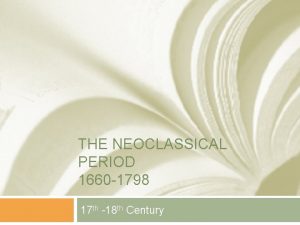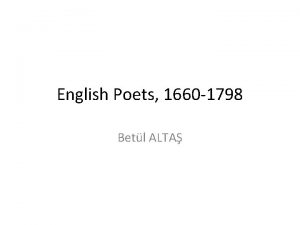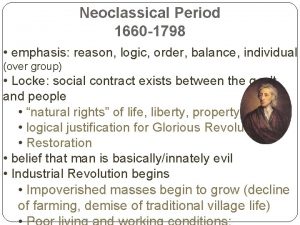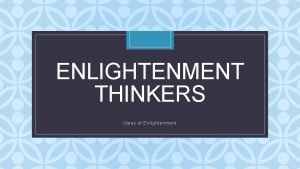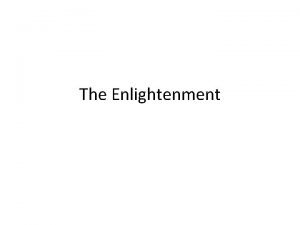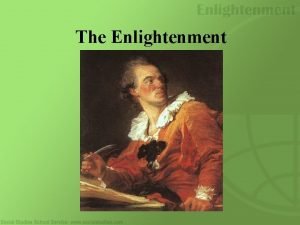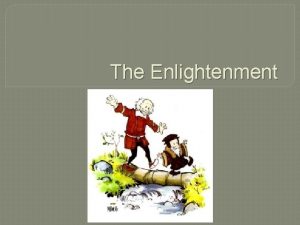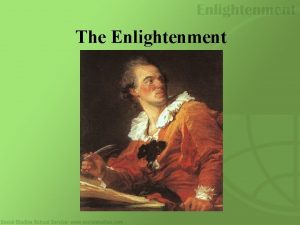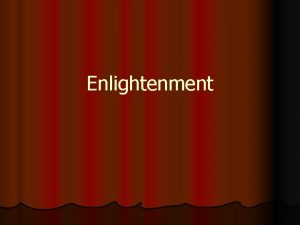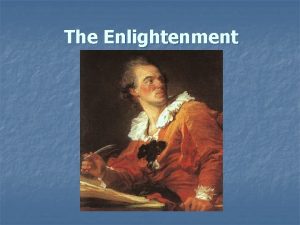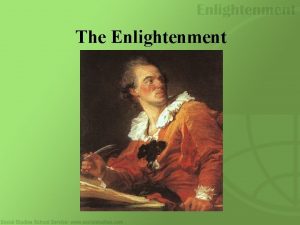Restoration And Enlightenment 1660 1798 The Restoration Refers





































- Slides: 37

Restoration And Enlightenment 1660 -1798

The Restoration Ø Refers to the restoration of the monarchy in 1660 Charles II - spent exile in France, patron of arts and sciences Ø James II Ø William and Mary Ø Anne - Scotland officially united with England to form Great Britain, outlived all 16 of her children Ø

Ø George III - suffered from mental illness, ruled for 60 years, political blunders resulted in the loss of the American Colonies

The Enlightenment Ø A philosophical movement that emphasized natural rights of life, liberty and property Ø Age of Reason Ø Sir Isaac Newton - order, balance, logic & reason, scientific inquiry was applied to everything from farming to politics

Ø Writers, artists, politicians, etc. , gathered in coffeehouses to exchange ideas, conduct business, and gossip

Improvements Ø Living conditions and changes in ways of life Ø Dramatic advances in agriculture Ø Breeding advancements yield larger animals Ø Steam power

Ø Industrial Revolution - changed way of life for all Ø Women and children labored long hours with low pay

Ø By the end of the period, a mass of restless, impoverished workers had grown.

Language Ø Samuel Johnson - Dictionary of the English Language (1755) Ø Robert Lowth - A Short Introduction of English Grammar Ø Based on Latin - rules often proved inappropriate for English Ø Overseas colonization brought new words and increased differences in spoken English

Literature Ø Neoclassicism Ø Stressed balance, logic, sophisticated wit, and emotional restraint Ø Birth of the novel - Robinson Crusoe Ø Toward the end of the period, poetry began to reflect themes close to the human heart - the first hints of Romanticism

Satire 18 th Century - The Golden Age of Satire

Satire ØA literary technique that mixes criticism with humor Ø Uses laughter as a weapon, usually to encourage social reform

Two Types of Satire Ø Horatian satire - playfully amusing, seeks to correct a vice or foolishness with gentle laughter Ø Juvenalian satire - darker kind of laughter, bitter and criticizes corruption or incompetence with scorn and outrage

Ø Comments on and criticizes society, makes fun of a topic by making it seem ridiculous Ø News commentators, political cartoonists, comedians, screenwriters, songwriters Ø The Simpsons - educational system, sibling rivalry, violence on TV, sports Ø Saturday Night Live, Mad TV

How to Recognize Satire Ø Author may clue the reader in that he is writing satire Ø Author may cite previous satires Ø Satiric subject matter and its treatment l l l Concrete, topical, and personal subjects Often alludes to the gossip of the moment Freshness is important - no one cares 50 or 100 years later

Style is easy to distinguish Ø Contains cruel and “dirty” words Ø Contains comic words and terms Ø Uses conversational and nonliterary language Ø Tries to produce the unexpected

Weapons of Satire Paradox Ø Antithesis Ø Parody Ø Anticlimax Ø Obscenity Ø Violence Ø Vividness Ø Exaggeration Ø Irony Ø

Jonathan Swift (1667 -1745) • born in Dublin, Ireland • father died, mother left • suffered from poverty • Kilkenny Grammar School • 1682 -86 Trinity College in Dublin • 1689 went to England : hoped to gain preferment in the Anglican Church worked for Sir William Temple met Esther Johnson – “Stella” • began to suffer from Meniere’s Disease • got a M. A. degree from Oxford

Religious Beliefs • was a clergyman, member of the Church of Ireland • a militant defender of his church • 1700 was instituted Vicar of Laracor and later promoted as Dean of St. Patrick’s Cathedral (Dublin) • attacked theological attempts to define and limit orthodoxy • the Church = a force for rationality and moderation • rationis capax

Political Beliefs & Later Life • first a member of the Whig party • later a member of the Tory Party • supported the Glorious (Bloodless) Revolution • became the editor of the Tory newspaper The Examiner When Tories fell from power, all hopes for preferement in England came to an end. He returned to Ireland “to die like a poisoned rat in a hole”. (his own words) Published many works, compiling tracts and poems and most importantly “Gulliver’s Travels”. By 1735 his MD had become more acute. Jonathan Swift died on October 19, 1745.

Jonathan Swift’s works Satires: Other: A Tale of a Tub The Journal to Stella The Battle of the Books Also wrote many sermons, prayers, etc. A Modest Proposal A Meditation Upon a Broom-Stick Gulliver’s travels Pamphlets: The Abolishing of the Christianity in England On the conduct of the allies The Barrier Treaty The Public Spirit of the Whigs Poems: A Beautiful Young Nymph Going to Bed Cadenus and Vanessa A Description of a City Shower

Introduction to Gulliver’s Travels Jonathan’s best fictional work Ø was published in 1726 Ø Travels into Several Remote Nations of the World, by Samuel Gulliver. Ø The book contains four parts, each dealing with one particular voyage during which Gulliver meets with extraordinary adventures on some remote island after he has met with shipwreck, piracy and other misfortunes. Ø

Lemuel Gulliver l l l l Narrator of novel Middle-aged, middle class, British Intelligent, well-educated Naïve Unaffectionate to wife A doctor on a Royal Navy ship who washes up on the shores of several fictional countries. Upon returning to England, he is painfully aware of his country’s flaws.

Ø Mrs. Mary Burton: Mrs. Mary Burton is Gulliver's wife. He only states her name at the beginning of the novel, and thereafter refers to her as his wife. She is mentioned only during his rare time in England.

Ø Captain William Pritchard: Captain Pritchard is the head of the ship named Antelope. He controls Gulliver's first voyage in which a storm overtakes the ship, leaving Gulliver stranded on the strange land of Lilliput.

A VOYAGE TO LILLIPUT The first part tells about his experience in Lilliput Ø The emperor believed himself to be the delight and terror of the universe, but it appeared quite absurd to Gulliver who was twelve times as tall as he. Ø In his account of the two parties in the country, distinguished by the use of high and low heels. Ø Religious disputes were laughed at in an account of a problem which divided the Lilliputians: “ Should eggs be broken at the big end or the little end? ” Ø

Main Characters Ø Lilliputians l l l Inhabit Lilliput Only 6 inches tall Prone to conspiracies and jealousies Ø Emperor l l Ruler of the Lilliputians Despite small size, loves being in control, exercising his power, and his large palace

Gulliver visits Lilliput Meets the Lilliputians He finds that the population is split between 'Big Enders' and 'Little Enders‘ Ø The Emperor who is keen to go to war with Belfuscu and the defecting 'Big Enders‘ Ø The Empress who originally likes Gulliver, but is then offended when he urinates on buildings to put out a fire Ø

A VOYAGE TO BROBDINGNAG Second Journey to Brobdingnag Ø In the second part, Gulliver is left alone in Brobdingnag where people are not only ten times taller and larger than ordinary human beings, but also superior in wisdom. Gulliver now found himself a dwarf among men sixth feet in height. The king, who regarded Europe as if it were an anthill. Ø Gulliver sold and used as a slave, mostly used for entertainment purposes Ø Discusses history and policies of his native country with the King Ø

Main Characters Brobdingnagiants Giants that inhabit Brobdingnag Ë Reasonable, gentle Ë The Queen Sweet, kind Ë Humorous, witty Ë The King Intellectual, rational Ë Does not know much about politics Ë

A VOYAGE TO LAPUTA, BALNIBARBI, LUGGNAGG, GLUBBDUBDRIB, AND JAPAN Ø The third part deals mainly with his accidental visit to the flying Island, where the philosophers and designers devote all their time and energy to the study of some absurd problems. Their scientists are engaged in projects for extracting sunbeams out of cucumbers, turning ice into gunpowder and making cloth from cobweb.

S S S S S Laputans Inhabitants of the flying island of Laputa which has diameter of 7837 yards. Munodi A Lord who lives in Lagado the metropolis of Balnibari Professors of various academies who take up Gulliver's suggestions Governor of Glubbdubdrib Struldbruggs who offer eternal life but become progressively senile in doing so. Maldonada A port Guldubdribb land of sorcerers Glangluenstand port of embarkation from Luggnagg Xamoschi landfall in Japan Nangasac where he meets Captain Theodorus Vangrult with whom he sailed back to England.

A VOYAGE TO THE COUNTRY OF THE Houynhms Final Journey to the Country of the Houyhnhnms S Horses rule the deformed Yahoos S Gulliver banished from their society S S S Feel he is a threat to their civilization Aware he has a resemblance to a Yahoo

Summary of Last Book The last part is the most interesting account of his discoveries in the Houyhnhnm land, where horses are endowed with reason and all good and admirable qualities, and are the governing class. Ø Contrary to the Houyhnhnms, the Yahoos possess every conceivable evil. They are malicious, spiteful, envious, unclean and greedy. Gulliver admires the life and ways of the horses, as much as he is disgusted with the Yahoos, whose relations remind him of those existing in English society to such a degree that he shudders at the prospect of returning to his native. Ø

Main Characters Yahoos Ø Yahoo’s an uncouth human-like race l Dirty, hairy, primitive, but human-like Many different kinds l Servants of Houyhnhnms l • Blonde, redheaded, dark-haired Houyhnhnms Ø A horse-like race who rule over the unruly l l Live in peaceful, simple society Rule with reason and truthfulness • Do not even have the word “lie” in their vocabulary

The end of the novel Ø The author takes his last leave of the reader; Ø proposes his manner of living for the future; Ø gives good advice, and concludes.

THEMES ØThe main object of the satire in Gulliver's Travels is human nature itself, specifically Man's pride as it manifests in “pettiness, grossness, rational absurdity, and animalism”. Gulliver's character, as a satirical device, serves Swift's ends by being both a mouthpiece for some of Swift's ideals and criticisms and as an illustration of them. Thus, criticism on human nature are made through Gulliver's observations as well as through Gulliver's own transformation from a “naive individual. . . into a wise and sceptic misanthrope, ” ØAs we travel with Gulliver through the voyages, Swift brilliantly peels away our pretensions, layer by layer, until he shows us what we are and challenges us, intensely and urgently, to be better. In Gulliver's Travels, Jonathan Swift continues to vex the world so that it might awaken to the fact that humankind needs saving, but it has to save itself. ØThe solution to the human dilemma is not as simple as Gulliver's rejection of humanity, and Swift's final success, in terms of stimulating response, is that, after masterfully dissecting and presenting the problem, he leaves the application of his lessons to “the judicious reader. ”
 Restoration period 1660 to 1700
Restoration period 1660 to 1700 The restoration refers to
The restoration refers to Renaissance (1537 ad - 1660 ad)
Renaissance (1537 ad - 1660 ad) The renaissance 1485-1660
The renaissance 1485-1660 Renaissance (1537 ad - 1660 ad)
Renaissance (1537 ad - 1660 ad) Robinson crusoe analysis
Robinson crusoe analysis Daniel defoe was born in 1660 into a family of dissenters
Daniel defoe was born in 1660 into a family of dissenters 1660 time period
1660 time period Mikroskop 1660
Mikroskop 1660 Mikroskop 1660
Mikroskop 1660 What word means rebirth
What word means rebirth The english renaissance 1485 to 1660
The english renaissance 1485 to 1660 Romantic period 1798 to 1832
Romantic period 1798 to 1832 The romantic period 1798 to 1832 summary
The romantic period 1798 to 1832 summary Romantic period 1798 to 1832
Romantic period 1798 to 1832 The romantic period 1798 to 1832 summary
The romantic period 1798 to 1832 summary Guinness the 1798 limited edition
Guinness the 1798 limited edition Auguste comte
Auguste comte American imperialism political cartoon
American imperialism political cartoon The romantic age (1798 to 1824)
The romantic age (1798 to 1824) Co je kalorikum
Co je kalorikum Chapter 3 the european period answers
Chapter 3 the european period answers 1798
1798 Romantic age starts from
Romantic age starts from Characteristics of romanticism
Characteristics of romanticism Hát kết hợp bộ gõ cơ thể
Hát kết hợp bộ gõ cơ thể Bổ thể
Bổ thể Tỉ lệ cơ thể trẻ em
Tỉ lệ cơ thể trẻ em Chó sói
Chó sói Glasgow thang điểm
Glasgow thang điểm Hát lên người ơi
Hát lên người ơi Các môn thể thao bắt đầu bằng tiếng đua
Các môn thể thao bắt đầu bằng tiếng đua Thế nào là hệ số cao nhất
Thế nào là hệ số cao nhất Các châu lục và đại dương trên thế giới
Các châu lục và đại dương trên thế giới Công của trọng lực
Công của trọng lực Trời xanh đây là của chúng ta thể thơ
Trời xanh đây là của chúng ta thể thơ Mật thư tọa độ 5x5
Mật thư tọa độ 5x5
